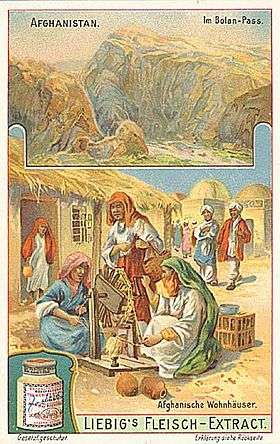Bolan Pass
| Bolān Pass | |
|---|---|
|
Bolan Pass depicted on a 1910 advertisement card for Liebig Meat Extract Company | |
| Elevation | 1,793.4 m (5,884 ft) |
| Location | Balochistan |
| Range | Toba Kakar Range |
| Coordinates | 29°45′N 67°35′E / 29.750°N 67.583°E |
The Bolān Pass is a mountain pass through the Toba Kakar Range of Balochistan province in western Pakistan, 120 kilometres from the Afghanistan border. It connects Sibi with Quetta both by road and railway. The pass itself is made up of a number of narrow gorges and stretches 89 km (55 miles) from Rindli north to Darwāza near Kolpur in the Balochistan province of Pakistan.[1]
Strategically located, traders, invaders, and nomadic tribes have also used it as a gateway to and from South Asia.[2] The Bolān Pass is an important pass on the Baluch frontier, connecting Jacobabad and Sibi with Quetta, which has always occupied an important place in the history of British campaigns in Afghanistan.
The local population predominantly consists of Brahvi tribes, who extend from Bolan Pass to Cape Monze on the Arabian sea.[3][4]
History
In 1837, threatened by a possible Russian invasion of South Asia via the Khyber and Bolān Passes, a British envoy was sent to Kabul to gain support of the Emir, Dost Mohammed. In February 1839, the British Army under Sir John Keane took 12,000 men through the Bolān Pass and entered Kandahar, which the Afghan Princes had abandoned; from there they would go on to attack and overthrow Ghazni.
"The road through this pass leads, with few and rare exceptions, along what is the bed of a mountain-torrent, when filled by the melting of the snows or heavy rains, and is composed of loose shingly gravel, that recedes from under your feet, and is very difficult for draught: camels get on well. It is infested by the Kakurs, who live by robbery; and the hills sometimes close in upon the road, which is filled up by the bed of the stream, running through rocky chasms, upwards of a hundred feet high, from the top of which the robbers assail the travellers with stones; and were they as bold as they are cruel and perfidious, they might hold the place against all comers. Many spots were pointed out to me by the guides I had with me, as signalised by acts of violence, several European officers having lost their baggage during our occupation of the country. Should there be rain in the higher parts of the mountains, the stream at times comes down in an almost perpendicular volume, without warning, and sweeping all before it, as a friend of mine experienced, when he saw a party of men, horses, and camels, and all his property, borne down by it; when himself and some few men with him escaped by climbing up the nearly perpendicular side of the hill. About thirty-seven men were washed away upon that occasion."[5]
In 1883, Sir Robert Groves Sandeman negotiated with the Khan of Kalat, Khudadad Khan, and secured British control over the pass in exchange for an annual fee.[6]
Bolān Pass railway
.jpg)
From Sibi the line runs south-west, skirting the hills to Rindli, and originally followed the course of the Bolān stream to its head on the plateau. The destructive action of floods, however, led to the abandonment of this alignment, and the railway now follows the Mashkaf valley (which debouches into the plains close to Sibi), and is carried from near the head of the Mashkaf to a junction with the Bolān at Machh. An alternative route from Sibi to Quetta was found in the Harnai valley to the N.E. of Sibi, the line starting in exactly the opposite direction to that of the Bolān and entering the hills at Nari. The Harnai route, although longer, is the one adopted for all ordinary traffic, the Bolān loop being reserved for emergencies. At the Khundilani gorge of the Bolān route conglomerate cliffs, which rise to a height of 800 ft., enclose the valley. At Siri Bolān the passage between the limestone rocks hardly admits of three persons riding abreast. The temperature of the pass in summer is very high, whereas in winter, near its head, the cold is extreme, and the ice-cold wind rushing down the narrow outlet becomes destructive to life. Since 1877, when the Quetta agency was founded, the pass was secured by the British Indian Army from militias of Baluch tribesmen (chiefly Marris).
Coordinates: 29°45′N 67°35′E / 29.750°N 67.583°E
See also
References
- ↑ Online version of Encyclopedia Britannica 4th Oct. 2014.
- ↑ Singh, Sarina (2004). Pakistan & the Karakoram Highway (6th ed.). Lonely Planet. p. 112. ISBN 978-0-86442-709-0.
- ↑ Minahan, James B. (31 August 2016), "Brahui", Encyclopedia of Stateless Nations: Ethnic and National Groups around the World, 2nd Edition: Ethnic and National Groups around the World, ABC-CLIO, pp. 79–80, ISBN 978-1-61069-954-9
- ↑ Shah, Mahmood Ali (1992), Sardari, jirga & local government systems in Balochistan, Qasim Printers, pp. 6–7
- ↑ “The Bolan Pass.”—Extract of a letter from an Officer of the Bengal Artillery, dated Camp at “Quetra,” or, more properly, “Shawl Kot,” in Khorasan, 2nd December, 1841. JRGS, Vol. 12 (1842), pp. 109-110.
- ↑ Singh, Sarina (2004). Pakistan & the Karakoram Highway (6th ed.). Lonely Planet. p. 113. ISBN 978-0-86442-709-0.
![]() This article incorporates text from a publication now in the public domain: Chisholm, Hugh, ed. (1911). "Bolan Pass". Encyclopædia Britannica (11th ed.). Cambridge University Press.
This article incorporates text from a publication now in the public domain: Chisholm, Hugh, ed. (1911). "Bolan Pass". Encyclopædia Britannica (11th ed.). Cambridge University Press.
